The last time I went to Shoreditch, I only peeped into Rivington Street. I caught sight of works by two of the greatest street artists Britain has produced, got excited, started clicking... and ran out of batteries. Plus, it was biting cold and it was a day when I'd been foolishly optimistic about the weather while dressing up. I had to beat a sorry retreat, albeit with a strong resolve to go back as soon as possible - with an extra set of batteries.
I was rewarded with that opportunity yesterday.
Do correct me if I'm wrong, but Rivington Street seems to me to be the mecca of street art in London. The first thing you notice when you enter the street from the Shoreditch side is Eine's famous (or infamous, depending upon how you're inclined to view street art) typography. It transforms the underside of this bridge from a dingy stinky passageway into an art gallery in its own right.
I was rewarded with that opportunity yesterday.
Do correct me if I'm wrong, but Rivington Street seems to me to be the mecca of street art in London. The first thing you notice when you enter the street from the Shoreditch side is Eine's famous (or infamous, depending upon how you're inclined to view street art) typography. It transforms the underside of this bridge from a dingy stinky passageway into an art gallery in its own right.
click on pictures to enlarge

On the opposite wall sits one of the entrances to Cargo, the live music bar, flanked on either side by graffiti - by someone whose name I haven't been able to trace yet. (Leads appreciated).


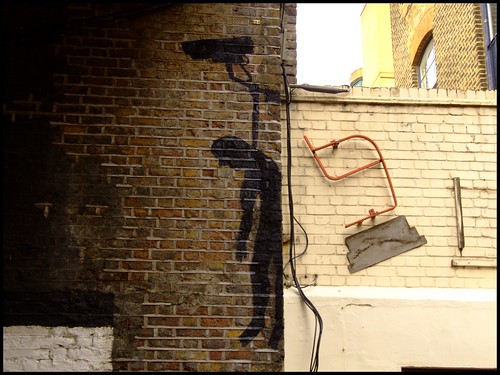
If this looks familiar, you probably saw it here
*Update: The two silhouette pieces above are by an artist called Sam3. Hat tip: Xylo
Cargo's courtyard/garden on the other side of this bridge is a haven for street art - it houses two famous Banksy works on each end, with multiple Shepard Faireys, an Ego Leonard and other street art in between:

Banksy's 'Designated Graffiti Area' - this one is so precious, it is covered with a pyrex sheet.
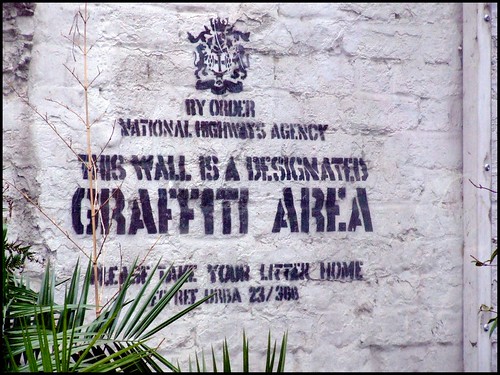
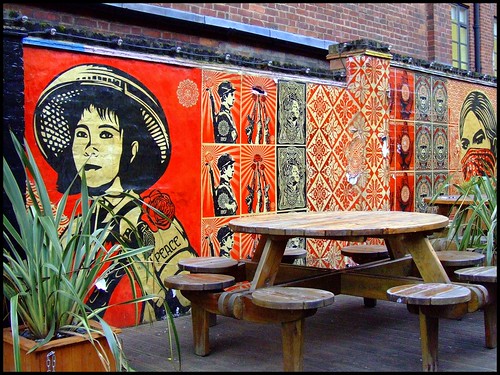
Shepard Fairey's 'Obey' posters

Unidentified - help appreciated

Ego Leonard's Lego
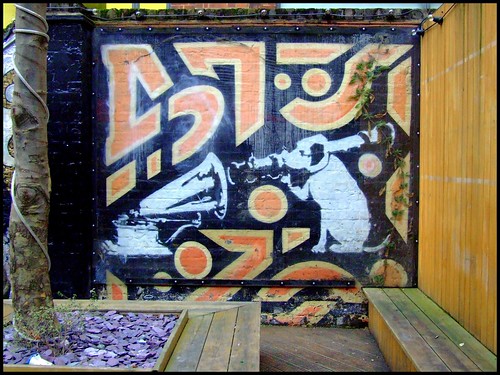
Banksy's HMV
I moved out of the rear exit of Cargo and into the courtyard (narrow alleyway) of the Black Rat Press and come across more street art - outside the gallery. And here comes the interesting part, if you haven't figured out from the name already, the Black Rat Press is dedicated to showcasing the best of street art and artists from around the world. It houses works by D'Face, Swoon, Brian Adam Douglas, Slinkachu and Nick Georgiou among others. The name of the gallery is of course taken from Banksy's signature black rat that has made appearances in several cities of the world.
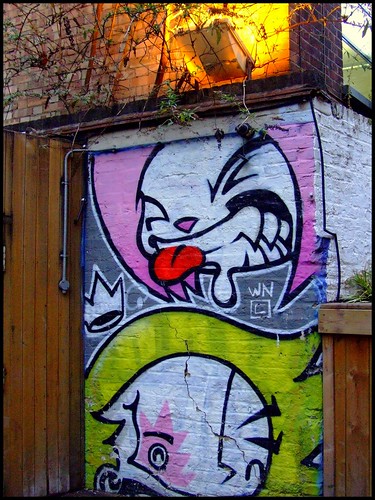
Unidentified, outside Black Rat Press. Any help?

Someone left their paints behind

Love the typography

Like Shoreditch, but less so, Rivington Street is a study in contrast - or perhaps it is a study in tolerance of extremes. The street is littered with art galleries showcasing formal, recognised forms of art, while the walls outside these galleries host works by some of the most well-known street artists. The David Adjaye designed Rivington Place, for example, has an exhibition on by well known South African photographer Santu Mofokeng. Right behind the gallery, enclosed in its own parking space, is a famous Stylo and Mear piece from 2001.
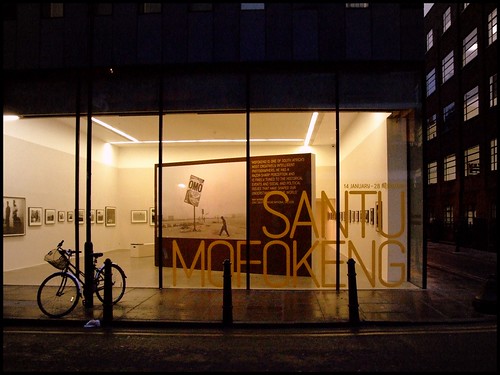

Rivington Street is obviously a place for artists, photographers and designers. Old world sentimentalities about art and design perhaps do not fit in here. Every establishment on this street - cafe, gallery, bar, shop - pays homage to eclecticism and acceptance, an almost-rebellious response to the old school. The contemporary parallels of slick stylishness and alternative movements coexist on the same street, a kilometre long stretch of bohemian utopia.

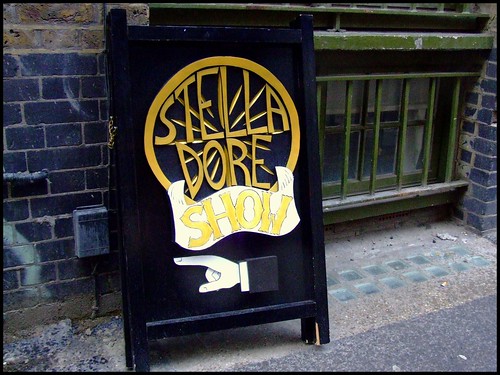
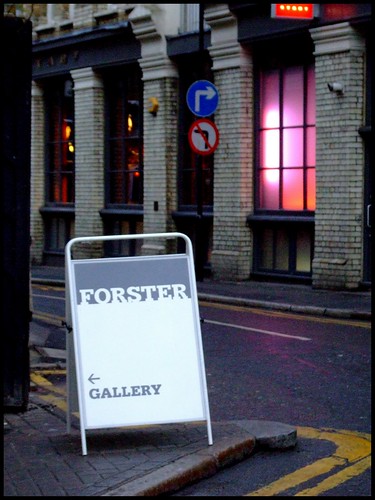
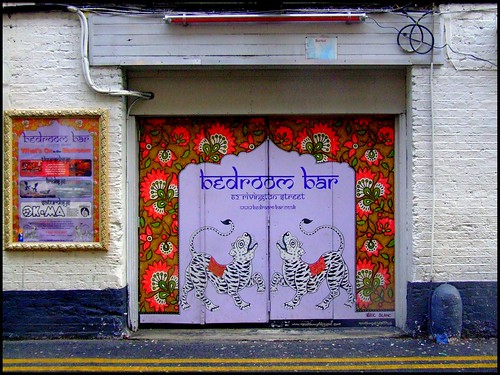
The Bedroom Bar
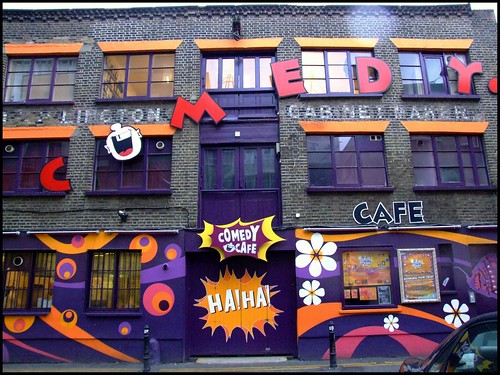
The Comedy Cafe
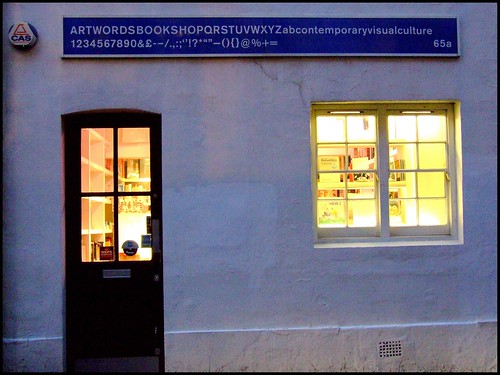
The absolutely lovely ArtWords Book Shop - a tiny treasure trove for resources on contemporary visual arts

I don't care what the puritans say about street art. I believe that as much as it can destroy the fabric of a place, not all street art is subversive. Some brings it back from disuse, back into acceptance and back into character from decay and Rivington Street is an excellent example of this. There is a fine line between mindless graffiti and street art, between wasteful self-indulgence and creativity - and instead of trashing all street art as vandalism, I think that line needs to be recognised and that distinction made.
So far this has been one street where I've felt completely at ease wielding my camera around. No one gave me a suspicious look, no curious glances were thrown my way. Instead, passers-by smiled at me, nodded in understanding, invited me into their galleries. I was running out of time so didn't step into many, but I'm so going back yet again. I had a fantastic time clicking this street despite the cold drizzle on my head, my struggle to keep my lens dry, and the failing light.
Oh, and the extra set of batteries helped - I ran out midway.
Oh, and the extra set of batteries helped - I ran out midway.
PS: If you have an opinion on this, I'd love to hear what you think about street art as a legitimate art form in the comments or on email.





16 comments so far:
hey flaneur-
this is absolutley delightful!
i am coming back with the outpourings a bit later- i need to relish this post with long hours of indulgence handy and some coffee on the side:)
i hope this sparks an original debate amongst us, wonderful initiation on the prevalent opinions and understanding of street art.
Interesting write up. Personally I find Rivington St. stiflingly bourgeois. The nice safe gallery sponsored sanitised version of street art is tolerated as a marketing tool, but anything genuinely subversive is quickly removed. Several street artists were arrested there last week by undercover cops on a stake out, because they don't like it if people interfere with it's image as a street art Disney world for tourists. This is how controlled and co-opted it is. Only the state approved artists are allowed, who reflect non-threatening middle class values. A hollow pastiche of rebellion is ok though, just as long as it doesn't go too far and become real. Sounds like the Soviet days of government directed art projects such as Communist 'realism' doesn't it. It's the street art version of murals of happy tractor drivers.
Also, regarding your comments about mindless vandalism, I'd rather see a wall of tags (which have a beauty all of their own, but are looked down upon by art world snobs due to prejudice and ignorance) than a lot of street art pieces which I know are just there as an advert for the artist's latest print release or gallery show, and as such function on the same level as a billboard. It's big business now, and a lot of it has lost it's authenticity. What I do find really offensive is the preference for plain black or magnolia walls in this increasingly gentrified sector of London. It reflects a sterile corporate image that a whole section of society feel excluded from. But I guess that's part of the intention behind it. Public space that is for and controlled by those who have the most money.
Shipra: Looking forward! I'm really looking to understand street art and the street art scene in London's East End in particular - and I do hope that it will spark debate and discussion.
Anonymous: Thank you for your comment:) Your comment is exactly the kind of insight I was hoping to gain through this post - the "what actually lies behind what I see". I am still relatively new to London - haven't yet completed three years and still see the city as part-outsider. In any case, the urban fabric of London is very different from the Delhi (India), my erstwhile residence and my analysis or observations come partly from that visual and sociological conditioning. You certainly shattered my perhaps over-romanticism of Rivington Street, but also piqued my intrigue of the underground art scene - the subversive, the anti-establishment. Perhaps you can tell me more?
However, at the same time, even with that insight, I cannot help but get attracted to Rivington St. as a 'public' art gallery - even if sanitised or sponsored by the moneyed quarters, as you say it is. Would love to know more, to discuss more. Hopefully we'll continue with the emails:)
Cheers!
I'm still very eager for more debate - bring on the counter-viewpoints!
Love the bookshop!
RednBlack: I did too! Tiny, but stocked to the gills with my kind of stuff :)
I've been meaning to have a look at Rivington Street for a while, your post might well motivate me to have a look this weekend.
You got some great shots as well, the Sheperd Fairy stuff in particular looks very interesting
Thanks Simon. It definitely is a very interesting street. I'm sure I'll be going back sometime.
Great shots and a great write-up. Last time I was there, the comedy cafe looked like this :
http://www.mar00ned.net/iblog/index.php?showimage=440 and http://www.mar00ned.net/iblog/index.php?showimage=134 .
I guess need to visit the place again.
Thank mar00ned. And thanks for the links - it's certainly changed! Given the interest in Rivington Street among London photographers, I'm wondering if we should organise a photo-visit together? I, for one, am really interested in digging deeper into street art politics in the East End.
Lovely colorful images! Vibrant colors...
The images are beautiful, and as snapshots, I love the one with the red scooter and the elements in the last pic, with the woman toting her bicycle.
I am still pondering on this post flaneur:)
You got some thought provoking feedback from...err...anonymous:)
Really valuable inputs. It gives us the complete picture, the other side of the coin so to speak- if I was to indulge in clichéd expression:)
The pictures you clicked as you loafed around in wonder:) are eclectic & pristine and comments dissect the world behind the veil.
What a story this post weaves.
Here goes something on the National Highway Agency, infamously clicked in one of your pics:) :
"In the UK, city councils have the power to take action against the owner of any property that has been defaced under the Anti-social Behaviour Act 2003 (as amended by the Clean Neighbourhoods and Environment Act 2005) or, in certain cases, the Highways Act. This is often used against owner of property that are complacent in allowing protective boards to be defaced so long as the property isn't damaged."
Source: Wikipedia.org
The two points of view on street art you mentioned are so extreme, and yet they do exist complacently. I on my part, am finding it very difficult to rationalize or align myself to either of the points of view: complete freedom & exaltation or complete control and suppression. Thanks to anonymous, we now know that Rivington Street exemplifies a manipulated version of the latter...
I will try to put down my ambivalent stance in words.
Art is expression, and as we know it, it is freedom of expression. But art itself, in all forms, needs a medium. Art has been challenged, criticized and celebrated and quite rightly so, but when the medium itself is judged as a form of debasement, the outrage does seem to mirror ignorance, a callous and superficial cause even for the puritans! (Boy! am I inviting trouble here :o)
Street art becomes a point of debate not because of fear of unorthodox or radical 'ideas' being injected in our environment (there's enough room on the internet for ideas/ art to thrive without being staked out). Instead, it enjoys opposition because it is quite simply seen as a tool for defacement of public/private property and by extension a defacement of cities, architecture and history at will. In a way it challenges security. A sense of self-preservation kicks in, and it is hard to let go. As a result, protectionist laws come into being.
At first glance, insecurity for something so mundane seems parochial, controlling and dictatorial! Shouldn’t history and culture be allowed to live it out- expand, explore and die-out if it is to be so, but naturally? But then, by that logic, any law would be defunct. While we as a species create, we also destruct. To put oneself in the legislative shoes, it is so hard to draw the line! How would we differentiate between street vandalism and art, or even define them? By the content, style/imagery, the property owner's disapproval or approval? What about the danger of street art becoming an imposition? We are all for the concept of freedom, but we also cherish our secure space and values, and the battle is ever present, even in our day-to-day lives.
It seems to me that legislation (personified!) had no other middle ground to choose from but to designate space for street art, in order to ensure preservation/security while simultaneously allowing this art form to stay alive. Whether it will thrive in its true form, is a questioned unanswered yet, it is in my opinion, too soon to judge that.
My understanding is that these controls on street art are implemented in two ways (I could be wrong about my impression!)- Commissioning a specific space to specific artists or just designating space without leasing it to a specific artist (which could lead to interesting graffiti wars!).
Commissioning has its disadvantages, I agree, and I fear. The most obvious one is that it usually involves a filtering of the idea/art expressed. The commissioner no doubt has the power to influence. Does it always lead to a stifling of creative expression? I think not. Of course, as time rolls on, time will also tell.
Going back to history, the world of art was no different. The channels of art were still controlled by varying degrees; they suppressed as well as propelled art. And the outcome, unless my view of history is completely distorted, is that we could not manage to debilitate Art (this consolation I hold dearly). Art is an indomitable force- and I have immense faith in this paradigm. A testimony to that fact could be that artists have, despite all odds, produced some of the greatest works under commission. The oldest cave drawings were in a way commissioned, as they were mostly created with approval. Wondrous and revealing time capsules in those drawings are potent and no less free.
On the subject of masterpieces made under commission, I was completely taken in when I first studied Michelangelo’s all consuming fresco, the Sistine Chapel. The commission to paint the ceiling, was an actually a kind of punishment. The church or the state commissioned most art back then, and the intention, sadly, was not giving complete freedom of ideas to the artist. Michelangelo’s poems describe the physical pain and the mental anguish he went through while painting this fresco. And still, it is a marvel, an irony that confuses, exhilarates and saddens me. Few people realize how entrenched it is in it's painter's agony. Pain here, clarified and distilled his art (which is a different subject altogether). And yet it leaves me wondering, what an unfettered Sistine Chapel fresco would have been. For all you know, if unburdened of compulsion, Michelangelo would never have painted it. He actually saw himself as a sculptor, not a painter. But I digress, ever so slightly☺
I will leave this post with a thought about his sculpture, David:
Magnanimously beautiful, exactingly precise, love standing still…and yet so alive that it seems it could move any moment!
I wonder if it would have been debauched or destroyed if Michelangelo’s sensual love for the male human body was well known or professed. Some still consider his relationship with the male body simply platonic, a purely neutral love for the beauty he saw in it. I for one don’t subscribe to that notion. This is art triumphing, in its own surreal way.
Abhijit: Thanks!
Shipra: Wow! Marathon commenting:P
I'll pick just one point from what you wrote: Commissioning. In my opinion, commissioning art is in itself a way of 'control' - a means of selection, to begin with, a way to straitjacket content, medium and even the artist (by choosing whom to commission - in which, politics of art couldn't remain far behind), and a means of exclusion (for artists or content that 'does not toe the line', or does not fall into conventional acceptance or acceptance by the moneyed quarters at any rate). Which, is exactly what is happening in Rivington Street as mentioned by Anonymous.
oh! :) i guess i totally WAS in THE marathon mode!
am a creature of impulse:D
when i started the comment, i had no idea where & when i would surmise my brief; then somewhere down the line, i realized that it was getting really really hard to end this comment! :) couldn't stop! haha...i guess it touched a chord- just like you had predicted.
agree- commissioning could be and often times has been a tool of control. but that really is just one side of the story. contrarily, it also promotes artists, and THAT has been of great vlaue in the evolution of art. in fact, the propagation, promotion and support for art that commissioning has provided throughout history, is staggering. you forget the lovers of art:) and yes...they do exist...they fiercely defend, promote, enrich & bolster the world of art! and that from just pure facts, even if you forget personal opinions.
surprised you feel strongly for/inclined towards the possibility of the negative aspect only...look up..look through...the sun shines...but well...each to his own! :)
until then
peace
ciao ciao
Shipra: I'm not inclined to only a negative, or for that matter, positive side to things. I'm only (strongly) inclined to keep the discussion pertinent to the topic of the post itself - in this case, Rivington Street. Which is why I picked on the notion of Commissioning as an agent of promotion, while Anonymous offers an insight hidden to most of us 'outsiders' - that on Rivington Street, that very tool is being used as a means of control and exclusion, while 'promoting' a certain section of art/artists that fetch the maximum amount of money.
Although I love and encourage healthy debate, I know that all too often, comment space on blogs can run berserk with digressive abstractions (speaking from experience of blogging and blog-watching in the past) and therefore as owner and moderator of the blog, I do need to steer conversations back to the point :) For everything else, there's email. :)
Oh, and the sun rarely shines in London, especially this week when there is none at all - could definitely do with some! :)
Cheers.
street art- noncommissioned- and making it to 'the gallery':
http://torontoist.com/2009/03/from_the_sidewalk_to_the_institution.php
Post a Comment
Thank you for your comments. I really cherish your feedback and discussion!